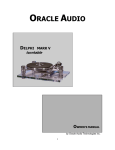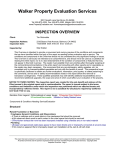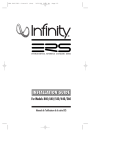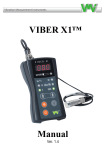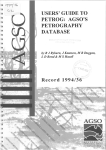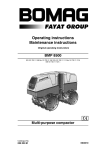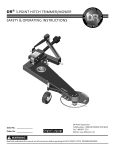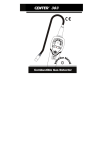Download Fire Safety Guidelines
Transcript
F OREWORD NGMA The National Greenhouse Manufacturers Association (NGMA) offers the following guidelines intended to minimize the risks of a greenhouse fire, and to minimize the losses should one occur. These guidelines include practical suggestions on fire prevention, safe work habits and emergency planning. Information was gathered from a broad spectrum of industry professionals and is presented in a manner that is easily understandable to the average grower. This document is not intended to replace codes, set standards or create specifications. The goal of this document is to promote awareness. Prevention is always preferred to remedy when it comes to fires, and fire prevention is everyone’s business. Reviewing these guidelines will assist in developing a good knowledge base of the issues of fire prevention and emergency planning when working with greenhouse designers, builders, sub-contractors, insurers, local code officials and fire departments on the front-end, as well as working with greenhouse employees to practice safe work habits on a daily basis. This document is not exhaustive, and each greenhouse operation may have special considerations that may not be addressed by these guidelines. Local officials, national fire prevention organizations such as the NFPA and many other sources can provide a wealth of information on fire prevention, safe practices, early warning systems and emergency planning beyond the scope of this document. Fire Safety NGMA I. Introduction A. Greenhouse Fires Many greenhouses are relatively isolated from the nearest fire station with the appropriate fire fighting organization and equipment. Greenhouse operations may lack access to an adequate source of water for fighting a fire. As commercial greenhouse operations become larger and more technically advanced, equipment and wiring may not be properly installed or maintained at all times. Plant containers, packaging, glazing and shade cloth are readily available combustible fuels. As a result of these compounding risk factors, fires can spread rapidly throughout the facility. Economic losses from a fire to a greenhouse operation can be out of proportion to the actual number of fires occurring. B. Fire Hazards in the Greenhouse Environment Growing plants commercially in a greenhouse is an extension of farming, which often places facilities in locations remote from fire fighting assets. Consequently, the longer reaction time gives an advantage to the fire. Fires start at a discrete point and can quickly spread through combustible materials. Due to expansions over time, greenhouse facilities are often open and inter-connected. Although there have been relatively few serious greenhouse fires, each one that does occur carries great risks that incr ease along with increases in the size of the operation, the value of the contents and crop, the use of modern plastics, and the use of automation including production, lighting, and environmental control. The materials that are used within greenhouses are chosen for their useful properties and features, however, these materials may come with undesired or unforeseen risks such as being a point of ignition or being combustible. Typically, a high light transmitting glazing material is not energy efficient when compared with building materials that can be insulated but do not transmit light. Modern plastics have been developed and applied effectively to improve greenhouse function and efficiency. Modern glazing and shading textiles have been engineered for features including light transmission, resistance to hail, wind, chemicals and improved energy efficiency. Modern packaging is relatively lightweight, attractive, inert, durable and inexpensive. Computer controllers open vents, turn on lamps and fans to create the environment that is defined to help crops thrive. These advancements have shaped the industry that exists today. We must realize, however, that the use of modern plastics and electric automation may offer a compromise between efficiency and risk. Electrical components can short circuit and emit sparks. Plastics release energy through burning. Because of these facts, we must recognize these undesirable features and manage the risks associated with them. We accept these compromises because we value these properties greater than the option of trying to use a greenhouse that is truly fireproof but useless for growing plants. The key is to reap all of the benefits by properly managing the risks. In addition to the make-up and contents of a greenhouse, the environment is unique. The greenhouse environment includes high levels of temperature, moisture, and sometimes UV light. Chemicals that may be aggressive to greenhouse systems and components are also present. All equipment, especially electrical, is subject to wear and degradation in an area of likely exposure to wet conditions. Fires in a greenhouse have been observed to move quickly throughout the facility. Crop and facilities are often severely damaged when a fire occurs. Fire interrupts the business that supports and impacts the lives of many including owners, employees and customers. Beyond the danger of the fire itself, is the threat of the loss of both short term and long term business. For these reasons, a greenhouse fire can be catastrophic to the owner. Fortunately, steps can be taken in planning and management that will both address fire risks, and produce the benefits that will result in a cleaner, safer and more efficient greenhouse operation. Many synergies exist between good fire risk management and good greenhouse operation management. The risk of a greenhouse fire will likely never reach zero, however, it can be managed to a level that will not threaten long-term business viability in the unfortunate event of a fire. 2 NGMA Fire Safety II. Greenhouse Fire Risks A. Risk Management Managing fire risk is becoming increasingly important to the success of a greenhouse business. There are three major risk management tools to consider: risk control, risk sharing, and risk communication. Risk control includes fire prevention, contingency planning, post-loss claims management and employee training. Risk sharing exists in the form of insurance. Risk communication should be present in employee orientation and training programs, in employee policies and handbooks, and through the identification of fire prevention and control resources throughout the greenhouse facility. B. Risk Assessment Greenhouse fire risks may be evaluated on a cumulative risk point concept. The more risk points that are accumulated, the more attention should be paid to control and share the risks of a fire. A risk assessment tool, such as the one described later in this guideline, should be considered when evaluating fire risk. If a high-risk rating is found, certain components and procedures may need to be altered to reduce the risk. As an entrepreneur, the greenhouse owner is ultimately responsible for determining fire risks and how they should be addressed. C. Greenhouse Fire Risks Fire requires three conditions to exist: combustibles, sufficiently high temperatures, and oxygen. All are generally present in a typical greenhouse operation. 1. Combustible materials: Plastic glazing materials, shade cloth, energy curtains, containers, packaging products, stored chemicals and fertilizers, and plant materials. 2. Sufficiently high temperatures: open flame devices (gas-fired heating appliances, CO2 generators, sulfur pots), sparks from electrical equipment and wiring, welding, soldering, or improperly discarded cigarettes 3. Oxygen D. Causes of Greenhouse Fires 1. Combustible Materials Plastic materials become sources of fuel once a fire has started and present a special risk. All polymers are combustible, whether they are acrylic, polycarbonate, polyethylene, polypropylene, polyester or fiberglass. They will burn when exposed to fire or high temperature sources. Their ease of ignition, rate and intensity of burning and the amount of smoke that is produced varies depending on the type and amount of plastic. Information about the flammability or combustibility of greenhouse plastics can be unclear. The burning characteristics of greenhouse components should be fully understood when designing new facilities and fire emergency plans, so that the risks can be appropriately addressed and managed. Fire retardant and resistant materials are sometimes available as an option, however, the costs and benefits must be considered. The components that prevent polymers from burning are often made of elements that, if burned, may release fumes that are toxic to both plants and people. 2. Fire Origins There are several sources of high temperatures that are commonly found around a greenhouse facility. The sight or thought of these items should conjure thoughts of ways that they can be safely used and maintained. a. Hot Work Maintenance personnel and contractors should be made aware of the dangers of soldering or welding near plastic glazing materials, shading or other combustible materials. Sparks and molten metal can ignite combustibles or fall into trays and start a fire that may not erupt until hours after the work is completed and the facility is unoccupied. 3 Fire Safety NGMA b. Heating Gas or oil-fired heaters, CO2 generators and any other combustion-type equipment in a greenhouse could create a fire if adequate clearances from combustible materials, such as shade cloth, are not adhered to. Adhering to the manufacturers’ installation and maintenance instructions and keeping equipment free of dust and debris will reduce fire risks, increase fuel efficiency and minimize undesirable by-products of combustion that can harm crops and occupants. c. Electrical Wiring problems and the degradation of electrical equipment can result in fires. Wiring often fails due to faulty installation, overloading or physical damage. Overloading circuits by connecting more electrical load than the circuit is designed to carry is a typical problem. Even properly installed electrical equipment and wiring can degrade over time due to aging, chemical action, heat, moisture and weathering. d. Spontaneous Combustion Spontaneous combustion has long been recognized as a fire hazard for many types of stored materials. In the greenhouse, this can involve oily rags in storage areas or oily products dumped into peat moss. Spontaneous combustion fires usually begin as hot spots deep within stored materials. The hot spots appear when a material, such as an oily rag, absorbs oxygen from the air as part of a natural chemical reaction. Heat generated by the oxidation then leads to fire. Fire caused by spontaneous combustion can occur at any time, day or night. Such fires can be very stubborn depending on the amount of material stored and the difficulty in finding the source of the problem. These fires are generally beyond control by the time of detection. e. Smoking Careless smokers cause many fires. Fires due to smoking usually occur when there is a lack of designated outdoor smoking areas and cigarettes are improperly discarded. Smoking should never occur inside buildings or areas where flammable and combustible materials are stored. Smoking should never occur near storage, shipping or receiving areas, where boxes or other containers can easily ignite. Another reason to avoid the use of tobacco products during cultural practices is to prevent infection of plants with the tobacco mosaic virus. Smoking should occur only in outdoor, designated areas, followed by hand washing before re-entry to cultural areas. III. Characteristics of Greenhouse Fires Fires start at one point then spread over surfaces. The fire may penetrate combustible coverings and move to adjacent areas either directly or through openings in the building construction. Once underway, a fire can spread rapidly through a facility as flame is propagated via flammable materials in the structure. Plastics that catch fire can drip at high temperaturestermperatures and ignite hanging baskets or flats and pots on benches below. Fires can be exacerbated under many circumstancs such as unintentionally adding oxygen to the fire by turning on fans or adding more combustible materials in the form of carelessly stored cardboard or plastics. High indoor air temperatures caused by fires can trigger HVAC equipment that will fan the flames if preemptive measures are not taken in the programming of the controls. Starving a fire of oxygen by keeping vents and doors closed may limit the extent and rate of fire spread, however, unburned gases can accumulate in a closed-up greenhouse and flashover can occur if a door or window is suddenly opened. In a flashover, hot gases rapidly erupt or explode into flames creating a very volatile and dangerous situation. Also, closed vents can cause smoke to accumulate, which creates vision and respiratory hazards for anyone trapped within the greenhouse. In general it is best to keep fans off, but to keep roof vents open. For obvious reasons, however, each greenhouse operation is unique and experts should be consulted when emergency plans are being developed. Properly handled agricultural chemicals do not cause fires, but some chemicals are highly flammable or even explosive. Some chemicals produce highly toxic smoke and vapors when burned or heated. A fire event or the act of fighting a 4 NGMA Fire Safety fire can mix incompatible materials to produce explosions or other dangers. It is extremely important to know the hazards of all chemicals. IV. Fire Prevention: A. Construction Recommendations 1. Technical Standards A well-designed greenhouse is the first step to fire prevention. Depending on the greenhouse type and use (i.e. retail, commercial, institutional), size and location, compliance to local building codes is essential. Building codes are designed for the protection of public health, safety, and welfare. The design and construction of any structure, including greenhouses, is governed by model codes, adopted and enforced by state and/or local building authorities. It is important to determine code requirements early in a project. Apply for any necessary variances up-front so critical delays and re-work are avoided during construction. Although adopted and enforced at the local level in most states, building codes are generally based on one of the following building code organizations: International Building Code administered by the International Code Council. Since January 2005, 455 jurisdictions have chosen International Codes as the building safety and fire prevention codes for their communities. Basic Building Code administered by the Building Officials and Code Administrators International (BOCA), Inc. Homewood, Ill, is governing in the Northeast US. Uniform Building Code administered by the International Conference of Building Officials (ICBO), Inc. Whittier, CA is governing in the states west of Illinois, Missouri, Oklahoma and West Texas. The Standard Building Code administered by the Southern Building Code Congress International (SBCCI), Birmingham, AL, is the governing code in the Southeast US. The National Electrical Code (NEC), NFPA-70, addresses proper electrical systems and equipment installation to protect people and property from hazards arising from the use of electricity in buildings and structures. The NEC covers, in part, installations of electric conductors and equipment within or on public and private buildings or other structures. It is important that electrical equipment within your greenhouse operation is designed and installed to code by qualified professionals. Many fires happen soon after an electrical appliance is improperly installed or maintenance is performed. 2. Compartmentalization Adherence to local building codes and the National Electrical Code (NEC) is the most important step in building design, however, there are other generally accepted rules of thumb to help prevent fires or their spread: • Separate greenhouses into as many fire zones as possible. Use non-combustible materials for walkways and partitions, and as firebreaks in glazing and shade cloth. • Isolate boilers from greenhouse glazing by non-combustible materials. • Do not locate ignition sources such as electrical panels and switches, heating pipes, CO2 generators, etc. in close proximity to glazing materials, shade cloth or energy curtains. Good fire design and layout will effectively compartmentalize different portions of your operation and risk. An operation with a sound fire compartmentalization design can also be configured as an efficient design for a good automation layout and efficient logistical layout. 5 Fire Safety NGMA Local building codes will provide guidance regarding minimum separation distances between greenhouses and other combustible buildings. This is important to help prevent fires from spreading to or from adjacent buildings. For example, greenhouses should not be built within 50 feet of any existing one story combustible buildings or within 100 feet of any existing two-story combustible building. Shops or fuel storage structures should be situated at least 100 feet from any other buildings. Greater separation may be required in high-wind locations, and/or if buildings are aligned with prevailing winds. Consider using a firewall whenever two areas with different risk levels are contained in the same building. For example, separate storage rooms, utility rooms and heating plants from the main greenhouse floor whenever possible. It is important to consider overall fire resistance-to-destruction when choosing building materials, especially for common walls or doors, by comparing fire ratings. Structural “fire performance” relates to the structure’s performance when a fire has become established and threatens a building’s structural integrity. Modern building codes state the fire performance of key building elements, such as walls (exterior, interior, bearing and non-bearing), floors, ceilings, roofs and doors, in performance terms such as hours of fire resistance. Building material, thickness and condition all influence performance. Consider the following fire resistance ratings for illustration: Thickness, Inches Construction Details Recommend Fire Endurance time, min 5” 2” x 4” stud wall; 1/2” gypsum board each side 30 3 1/2” Steel stud wall; 3/4” gypsum plaster each side 45 3/4” Panel door 5 2 5/8” Solid Oak Door 60 - Steel Fire Door 60 Although the items listed in the table above are not typical greenhouse building materials, the list does illustrate the difference in fire endurance times. Keep in mind that any obstructions to fires can buy time, either for an evacuation or to help save a portion of a facility. A closed door will buy time and during a fire, time is important. 3. Building Materials a. Metal Framed Buildings Many believe that metal-framed buildings, such as greenhouses, are “fireproof”. Although the flame spread rating for metal is 0, an unprotected metal frame building will fail much more rapidly than a wooden structure. Temperatures build up very quickly during the early stages of a fire, and often spread through the building more rapidly than the fire itself. As metal structural members get hot, their strength decreases rapidly. The result can be a complete structural collapse long before actual flames spread through the building. b. Fire-Retardant Glazing All plastic materials used as greenhouse glazing are combustible and need to be protected form high heat sources and open flames. Edges of the plastic sheet are more susceptible to accidental ignition than flat surfaces, and must be protected by metal or other noncombustible materials. 6 NGMA Fire Safety Plastic glazing materials, in order to be recognized as “approved light transmitting plastics” under the provisions of the model building codes, must meet certain minimum performance criteria as measured by small scale laboratory tests. Approved plastics are required to have a self-ignition temperature in excess of 650 deg F as determined by laboratory test standard ASTM D-1929, a smoke density rating of less than 75% as determined by standard ASTM D-2843, and be classified as either CCI-1 or CC-2 based on their burning characteristics as determined by ASTM D-635. These three test standards ensure that plastics used reduce the risk of a fire starting, and slow the spread of fire as much as possible. c. Fire-Retardant or Fire-Safe Screens Shade cloths may spread fire quickly, especially if they are made of easily ignited and flammable materials. Polymers used to make shade cloth, once ignited or exposed to flame, may melt and drip. Dripping polymers can cause damage to plant products and ignite other flammable materials such as pots and trays. Shade cloths or other environmental screens vary in the damage they may inflict based on the mass of the material burning. Earlier, moreMore massive polymer screens burn more intensely, giving off more heat and drips that can result in more damage. Potential wiring problems that can result in fires should be corrected. If wires are in contact with shade cloth at any point in its coverage area, friction against the wiring is likely to result as the shade cloth is opened and closed. Friction can wear away the insulation and expose a hot wire to shade cloth. One way to prevent this hazardous situation from occurring is to have all wiring in ceilings, routed away from any moving systems and encased in metal conduit. Ensure that heating appliances and exhaust pipes are always at least 36 inches from shade cloth. Ideally, use double-walled vent pipe, labeled as “Class B gas vent.” A metal thimble should be used where the vent passes though combustible material, such as a greenhouse end-wall or roof. Shade curtains are generally closed at night to conserve energy. This creates additional risk in that there is a continuous panel of combustible material, and at night, a fire may not be discovered in a timely manner. A shade system should be opened in the event of a fire to prevent the spread of flames from one panel to the next. This can be integrated into a smoke detection system to retract the shade automatically in the event of a fire. Flame retardant shade cloth is available and should be considered as a possibility by every grower. Shade cloths can be deemed “Class A” flame-retardant if the flame spread index is less than 25, as determined by the ASTM E84 standard, entitle, Surface Burning Characteristics of Building Materials. A “Class A” building material corresponds to Type I in other codes such as IBC, SBCCI, BOCA, and ICBO. Flame retardant shade cloth is generally more costly, but insurance premium deductions for using flame-retardant panels may offset the additional cost of flame retardant shading or energy curtains. A less costly alternative that can effectively create greenhouse divisions is to install some panels of flame-resistant panels as firebreaks. It should be noted that there are no laboratory tests to verify the effectiveness of this procedure, but field tests indicate that it can be an effective precaution. Some energy curtains are available with integral firebreaks. While the entire panel may not be flame retardant, the edges are so that a fire will not spread from panel to panel, effectively limiting the fire risk to one small area.. This style of shade or energy curtain will not be as costly as completely flame retardant panels. Heat retention pockets or perimeter seals should always be constructed of flame retardant materials. A combustible perimeter seal can transfer flame from panel to panel even if the curtain is “open” and the panels divided. Another approach is to construct firewalls made of noncombustible materials within the system. A flame retardant material should always be used to divide a greenhouse from a storage area of combustible materials. Out of a rising awareness of the risk that flammable shade and energy curtains, an independent institute, TNO, has created the following risk assessment tool for greenhouse shade and energy curtains, or screens as they are called in Europe. 7 Fire Safety NGMA 4. Greenhouse Fire Risk Assessment 1. Review the five questions, and circle one answer only for each question. 2. Add the number of points for each answer given. 3. Evaluate the risk category. Factor Resulting Points 1 Greenhouse size 2 Glazing type 3 Lighting > 2.5 acres (1 pt.) Glass (1 pt.) No assimilation Lighting (1 pt) 4 Other flammable items None (1 pt.) 5 Value of crop and greenhouse Low (1 pt.) Total Score Between 2.5 and 7.5 > 7.5 acres (5 pts.) acres *3 pts.) No flashover, e.g. Flashover, e.g. Polycarbonate (3 pt.) PMMA (5 py.) Assimilation lighting (5 pts) Other items, such as EPS growing contrainers, sequential cutrains, etc. (5 pts) Average (3 pts) High (5 pts) Add together the points from your answers Risk Assessment <8 points Your greenhouse has low fire risk Between 8 and 18 points Your greenhouse has an average fire risk. Use of a shade or screen with firebreas is recommended >18 points You have a greenhouse with high fire risk. Use flame retardant or shade or energy curtains with firebreaks is recommended Source: TNO A risk assessment tool such as the one above is only an indicator of the character and magnitude of fire risks. Nothing should be derived from it other than its value as a tool in estimating the fire risk of one’s operation. Greenhouse owners are ultimately responsible for determining the risks and how they shall be covered. The above points system is intended only as an aid in this process of risk assessment for commercial production greenhouses. 5. Cooling Pads Cooling pads are typically made of Kraft paper. Cooling pads typically have no fire rating and will sustain combustion if ignited. In the event of a fire in the pads, power should be disconnected from fans to prevent drawing air through the burning pads. However, the pump power should remain on to keep the media wetted. 6. Power Delivery Many fires result from defects in, or misuse of, the power delivery system. Wiring often fails due to faulty installation, overloading, physical damage and deterioration due to aging, chemical action, heat, moisture and weather. Knowledge of such wiring issues should prompt replacement and new circuit installation. Make sure that power needs are met without overloading your electrical system. All electrical wiring and equipment should be installed and designed to comply with the National Electrical Code (NFPA-70) and/or local electrical ordinances. These standards are generally reasonable and following them will not increase the cost of the power delivery system. Use good materials and proper fuse size or circuit breaker ratings. Use junction boxes at all splice points. 8 NGMA Fire Safety In a greenhouse environment, it is wise to use waterproof wiring, waterproof receptacles, and enclosed electric motors or similar devices in any buildings that are cleaned periodically with high-pressure washing equipment. Overloading circuits by connecting more electrical devices than they are designed to handle is a typical problem. Do not overload circuits. Dimmed lights and reduced output from heaters are symptoms of an overloaded circuit. Add up the amp draws of electrical devices and lights on each circuit. Keep the total amp load at any one time safely below the maximum amp capacity. When temporarily using a high amp load device, switch off all other unnecessary electrical devices. Connect into a circuit with little electrical power demand. Each circuit must be protected by a fuse or circuit breaker that will blow or break when its safe carrying capacity is surpassed. Any circuit will take a temporary overload, as when a motor starts, for example. Time delay (slow blow) fuses will handle this. Circuit breakers provide time delay, and are the preferred type of protection for general use. Avoid areas of excessive moisture for the location of the main electrical panel box. Locate the panel box in the driest, most dust free area possible. Because of the indoor environment of a greenhouse, the panel box should be corrosion resistant and weatherproofed, even if installed inside. Outlets and switch boxes should be made of metal and have dust- and water- tight spring-loaded covers that close when released. Wires should be encased in conduit. Protect panels, outlets, switches and wiring from heat, sun and water leaks.sun. Overheating causes premature breakdown of electrical components. A secondary disconnect switch to all electrical fans and unit heaters should be located outside of the greenhouse. Key personnel should be instructed to disconnectcut the power supply in the event of a fire to stop all air and heat flow. Keep in mind that power will be needed to open shade cloth and pump water through cooling pads. 7. Installation Quality Fires sometimes occur immediately following the installation or repair of mechanical and lighting equipment. Using qualified, licensed and insured professionals to design, install and service these devices and their power delivery systems will help to eliminate fire risks due to improper installation usage. By using licensed and insured professionals for these services, owners also reap the added benefits risk sharing with these professionals should a problem occur. In any case, only qualified or otherwise authorized personnel should check and test all new equipment to see that it operates properly prior to putting the equipment in full service, and on a routine basis while in use. 8. Lights Protective metal or non-combustible conduit should be used whenever possible for protection of electrical lines used for over bench lighting. Maintain a regular maintenance program for all over bench lighting. Light fixtures should have dust and moisture resistant covers. Incandescent bulbs should be surrounded by a globe cage to prevent accidental breakage, with seals that are dust and moisture-proof. General installation recommendations include: • Keep a safe distance between the fixture and combustible material. Consider the wattage of fixtures and failure modes. • Use only approved fittings. • Install according to NEC standards • Repair & replace using only original or manufacturer-approved components. 9. Fans & Motors Overheating due to excessive dirt, overloading, poor ventilation, arcing or sparking could ignite combustible material on or near a motor. Keep the area around motors and heaters free of flammable or combustible materials. Provide plenty of ventilation for motors and keep them clean. Internal failures or shorts could cause a motor to burst into flames. Motors, such as the type used for fans and water pumps should have moisture/dust proof on/off switches. A clearance of 18 inches should be kept between motors and any combustible material. A fire resistant shield should be placed around such material to protect it from heat given off by a motor. Make sure that fans are wired according to the NEC. Make the inspection of fans and motors a part of routine maintenance. Check voltage and amperage to see if it corresponds to motor nameplate. 9 Fire Safety NGMA 10. Appliances & Tools Over time, most electrical devices are subject to internal wiring failures or faulty power cords and switches that add to fire risk. All appliances used in the greenhouse should be UL approved and properly grounded. Appliances with broken, frayed cords or bent plugs should not be used until properly repaired. If an electrical device does not work, works poorly, makes unusual noises, smokes, smells burnt, issues sparks or pops, unplug it immediately and have the problem fixed. Wrapping a cord in electrical tape is not a proper method of repairing a frayed cord. All appliances should be disconnected when not in use. If an electrical fire starts at a wall outlet, pull the plug by the cord or turn off the main switch. Call the fire department, give them your address and tell them it’s an electrical fire. If the fire is small, use your CO2 (Class C) fire extinguisher. Never put water on an electrical fire. 11. Combustion Heaters & CO2 Generators Combustion-type heaters must have adequate clearance from combustible materials as directed in their installation & service manuals. Unit heaters should have 18 inches at the sides, back and bottom and 6 inches at the top when the unit has an internal draft hood. If the heater is UL listed, it will have a metal plate providing information about venting and minimum clearances from combustible materials necessary for safe operation. Contact the manufacturer for this information if the plate or the installation & service manual are missing. Portable heaters often do not contain safety devices that prevent overheating and should not be left unattended. All heating units should be well supported. The supports should be designed to eliminate any excess vibration or overloading of the greenhouse structural load limits. Blower bearings must be checked regularly for excess wear and proper lubrication. Gas and oil line piping and connections to all heating equipment should comply with local codes and manufacturer requirements. Regularly check for leaks, and any leaks found should be repaired immediately. All safety devices and controls for the protection and operation of a hot water or steam boiler should be checked regularly. Any control that is not functioning properly should be repaired or replaced immediately. Most boiler failures are caused by the failure of the operating safety limits, or appropriate ranges for temperature, water level and pressure. Operating and maintenance instructions should be rigidly adhered to. Only fire retardant or non-combustible material should be used over all space heaters, CO2 generators and around all flues. CO2 generators are open flame units, which should be kept at least 36 inches from combustible materials including shade cloth. A generator must include a primary gas safety control that will prevent the release of gas if the pilot light blows out. 12. Fire and Smoke Early Warning Detection Research shows that smoke alarms could reduce annual fire fatalities by half. Smoke alarms alert you to potential dangers that your senses cannot detect, such as a slow, smoldering fire in an overloaded electrical circuit. It is, however, dangerous to rely on a smoke alarm system that does not work properly. Check the operation of the smoke alarm frequently and regularly. Local building codes and local fire departments can provide guidance on the location and numbers of smoke detectors and alarms. A. Organizational Recommendations 1. Management and Maintenance Good maintenance practices will extend the life of your equipment and ensure that it works when it is needed. It will also identify and eliminate fire risks. Many greenhouse fires are the result of sparks or excessive heat created by poorly maintained or neglected equipment. Set up a maintenance program based on the equipment manufacturers’ recommendations, your own experience and common sense. 10 NGMA Fire Safety 2. General Guidelines • Test your fire or smoke alarm system frequently. • Flush outside private fire hydrants at least once a year. • Check all fire doors and shutters on a regular basis to make sure they are free of any obstructions and in good operating condition. • Regularly check all water control valves, and the air and water pressures of automatic sprinkler systems. • Inspect all wiring, electric motors and appliances for exposed wires, broken insulation, improper grounding and improper installation. • Equip motors and appliances with thermal overload relays or ground fault circuit interruption in accordance with the motor specifications. • Check the heating system to make certain that every furnace is in good repair and operating properly. • See that fans are clean of dust and debris, motors are cleaned each season, and pulley belts are in good working order. • Check gas and fuel oil systems for leaks and unsafe installations. • Keep all types of heating devices and other equipment clean and in good condition. 3. Fire Extinguishers Fires start small and grow big. A good fire extinguisher in the hands of a person who knows how to use it can often prevent a small fire from becoming a major loss. Select and provide proper and approved fire extinguishers. Each workplace building must have a full complement of the proper type of fire extinguisher for the fire hazards present. There are different types of fires, and each requires a different type of extinguisher: Class A: ordinary combustible material fires Class B: flammable liquid, gas or grease fires Class C: energized electrical equipment fires Extinguishers should be free from obstructions or blockage. Extinguishers should be of 5-lb minimum, although 10-lb is better. Ensure that employees are trained on selecting and using the proper extinguishers. Fire extinguishers must be serviced, maintained and tagged at minimum intervals, never exceeding one year, as specified by the manufacturer or by local codes. Even if a unit is only partially discharged, the extinguisher must be completely recharged. Recognize the limits of your personnel, and always think safety first. If an owner prefers to evacuate employees rather than having them fight small fires, there must be written emergency plans and employee training in place for proper evacuation. Make clear what procedures are to be followed to alert others in the event of a fire emergency. An educational program for the purpose of instructing all employees on the proper use of fire extinguishers and other fire safety and prevention should be scheduled at least twice each year including the actual use of the equipment and equipment location. New employees should be instructed during the first few days of employment. Extinguisher placement is important. The general rule of thumb is that extinguishers should be located close to potential hazards, in the middle of long aisles and near exterior doorways. Extinguishers should be mounted within 75 feet of outside areas containing flammable liquids, and within 10 feet of any inside storage area for such materials. Potential hazards include flammable and combustible storage areas, electrical panels, high voltage equipment, CO2 generators or any other ignition source. Your local fire department can provide more concrete guidelines for the location of fire extinguishers. Fire extinguishers cannot do the job of a local fire department. When a fire burns for more than a couple of minutes, the heat accumulates and intensifies. At this stage, the correct action is to get out 11 Fire Safety NGMA of the building and let firefighters handle the situation. Not all employers will wish to have their employees fight small fires and it is perfectly acceptable to have employees evacuate and call the fire department in the event of a fire. Garden hoses should not be considered adequate for fire fighting. A garden house is typically ?_ inch in diameter, compared with 2 ?_ inches for a fire hose, and cannot nearly deliver comparable volumes of water in a short period of time. Although a garden hose is ineffective for addressing fast burning fires, one should consider using a hose to moisten combustible material and equipment in the greenhouse. For example, you may prevent the spread of flame through a shade cloth by simply wetting it with a garden hose. You may also prevent flats and pots from burning and limit crop loss on a bench by turning irrigation booms on. Personal safety is always paramount, and firefighting options should be considered well before the outbreak of fire. 4. Storage of Combustibles and Accelerants Flammable and combustible liquids are a well-known fire hazard. These liquids can pose some difficult storage challenges if they are to be kept in relative safety. Accelerants are substances that increase the speed at which fire spreads. Common accelerants include gasoline, kerosene, diesel, oil and aerosol cans. All accelerants are highly flammable or combustible, but not all highly flammable or combustible materials are accelerants. Accelerants must be stored in approved containers and properly labeled. The first consideration is location. For example, when storing large quantities of flammable and combustible liquids, the optimal storage facility is an open, outdoor area, well separated from major buildings, property lines and streets. When neither open nor enclosed outdoor storage is possible, a suitable indoor location must be provided. Three possible configurations for indoor storage locations are, in order of preference: attached buildings, cutoff rooms, and inside rooms. All three are dedicated storage rooms for flammable and combustible liquids, but each has its own required features in terms of construction and arrangement. Attached buildings share a common wall with the main building, but are otherwise located outside it. Cutoff rooms share at least one common exterior wall with the main building, but are located inside it. Inside rooms are wholly contained within the main building. Regardless of the style of room, they should be dedicated rooms for storage of flammables and combustible liquids. The room should be clearly labeled and secured. The location and inventory of combustible and flammable liquids should be noted in the fire prevention and emergency response plans. The inventory should include the name of the chemical, date purchased, the quantity of the chemical, and the storage location in the greenhouse complex. This list should be kept in a safe, handy place such as an office. In case of a fire, the list should be given to the fireperson in charge, to inform the fire department about potential toxic fumes or explosions that may result, and how best to contain the situation. Flammable liquids should be stored in approved and labeled safety containers in flammable liquid safety cabinets. Above ground fuel storage tanks should be separated from all buildings. Chemical and flammable storage rooms should include ventilation and spill containment designs in accordance with local codes. 5. Fire Prevention and Emergency Response Plan A fire prevention plan ensures that fire safety is an integral part of all greenhouse operations, and that appropriate duties are assigned. The emergency response plan ensures that, in the event of a fire, you and your employees know what to do in order to preserve the safety of all personnel and to minimize the damage to buildings and equipment. It is your duty to provide written fire prevention and emergency response plans and appropriate training to all employees and contractors. You should refer to local codes and to the Occupational Safety and Health Administration (OSHA) for guidance in developing these plans. OSHA Fact Sheet number 93-41 covers workplace fire safety. 12 NGMA Fire Safety An alarm system is the preferred means of alerting employees to a fire, they should be included in your plan, and they should be available throughout the workplace to alert for evacuation. When a fire breaks out in a greenhouse or any other building, all occupants must be evacuated immediately. Exit routes from buildings must be clear and free of obstructions and properly marked with signs designating exits from the building. As normal exits may be blocked, it is compulsory that emergency exits exist. Emergency exit plans let you rely on automatic responses during an actual emergency. Knockout panels should be located in the greenhouse sidewalls and gable ends. Employees should be taught how to get out of a greenhouse or building as quickly as possible in an emergency. When everyone is out of harm’s way, call the fire department. Give your name, address and the exact location of the fire. Have the person you are talking to repeat your instructions. Never allow anyone to reenter a burning building. Special procedures for helping physically impaired employees must be addressed in the plan. The plan must include procedures for those employees who must remain behind temporarily to shut down critical plant equipment before they evacuate. Doors and windows should be closed when escaping a fire. Failure to do so may cause air drafts, which will fan the fire. Conduct regular, unannounced fire drills, so all employees know what they should do. After a drill, hold a meeting to discuss improvements in procedures and equipment. Drills and training can be included along with educational programs. 6. Hot Work (welding) Rules Hot work is common in a greenhouse, and is an especially high-risk situation. Written procedures must be available, adhered to and enforced with a “no exceptions” policy. a. General Guidelines: • Remove flammable or combustible materials from the area (35 feet) • Have working fire extinguishers at the location of work • Designate a fire-watch person who is to have no other responsibilities when the work is taking place, but to stay alert and to take appropriate action (stop work, sound alarm, fight fire) in the event of a fire. • Make all potentially impacted employees aware of the fact that hot work is taking place. • Shield thermoplastic glazing or shading from exposure. 7. Housekeeping General housekeeping is extremely important as fires spread rapidly through accumulated trash and debris. No trash or debris should be allowed to accumulate in buildings or greenhouses. It should be removed prior to the end of each workday, and properly disposed of in an open outside area or noncombustible container. These measures will make your greenhouse operation more fire-safe, more attractive to visitors and less attractive to pests. It is important to control grass and weeds within 100 feet of all greenhouses and service buildings. If a combustible type glazing is used in the greenhouse sidewalls and gable ends, grass and weeds should not be allowed to grow within 10 feet of the outside perimeter. a. General Guidelines • Make good housekeeping part of your daily routine. • Keep work areas clean, dry and unobstructed. • Never block exits or aisles. • Check for excessive accumulations of dust & debris. • Find a place for everything and keep it there. 13 Fire Safety NGMA • Prevent the accumulation of flammables in non-designated areas. • Store flammables, combustibles and chemicals in their proper areas and in approved containers. • Ensure that escape routes are not obstructed. Adherence to these guidelines will prevent potential hazards from being hidden, and will improve the efficiency of operations. 8. Inspections Inspections are necessary to ensure compliance with the fire prevention plan. Checklists should be used during inspections, and should include checks on: • The location and maintenance records for fire fighting equipment. • Housekeeping practices. • The physical condition of equipment. • Escape routes to ensure that they are not obstructed. • Employee practices regarding smoking, and observation of other fire safety practices. • Proper storage of flammables, combustibles and chemicals. • The proper operation of smoke alarms. Electrical equipment should be routinely inspected for excess dust accumulation and loose connections. Electric motor trouble can often be quickly identified using surface temperature measurement with an inexpensive infrared thermometer. 9. Insurance Coverage Loss prevention agents should make annual inspections, and help the grower develop and implement routine fire safety inspections for greenhouses, head houses, offices and storage buildings. Request lower premiums when extra fire safety precautions are taken during the construction or updating of a greenhouse. Some may be above and beyond the standards required by the local codes. Prior to accepting bids on new construction, submit detailed drawings and estimates to your insurance company for suggestions and recommendations. 10. Keep Local Fire Department Informed Invite your local fire department to your facility. Let them get acquainted with your facilities and help identify any potential fire hazards. Ask for their input in making your operation more fire-safe and fire-resistant. The fire department will be concerned with stored materials, fuel tanks and locating a local water supply. 14 NGMA Fire Safety V. Conclusions Greenhouse fires are a significant threat, and prevention is the best remedy. During new construction and renovations, coordinate appropriate building materials and greenhouse divisions that are determined by the relative risk of the operation. Metrics for evaluating risk, such as the one described earlier in the guideline, include facility size, electrical equipment used, type of glazing, and the value of the crop and facility. Small fires can result in a catastrophic loss if employees and fire departments are not prepared to react. Preparation for a a fire emergency is as important as prevention. Local fire officials should be invited to tour the facility and notified as expansions occur and equipment is added. Greenhouses will collapse when the fire has progressed to the point where structural members are weakened by excessive heat. Fire emergency plan strategy, execution and speed will determine the firefighters’ ability to enter a burning structure in an attempt to limit the loss. The fire department must know before arriving on site the location of the nearest, adequate water supply. Fire departments should also know the layout of the facility to strategically protect assets or particularly sensitive storages. If your greenhouse operation is particularly large, valuable, or represents a significant portion of your overall net worth, consult an appropriate risk manager and/or professional fire prevention expert for advice. PLEASE VISIT US ON THE WEB: www.ngma.com [email protected] 4305 North Sixth Street, Suite A Harrisburg, PA 17110 800-792-NGMA (6462) 717-238-4530 FAX 717-238-9985 15















